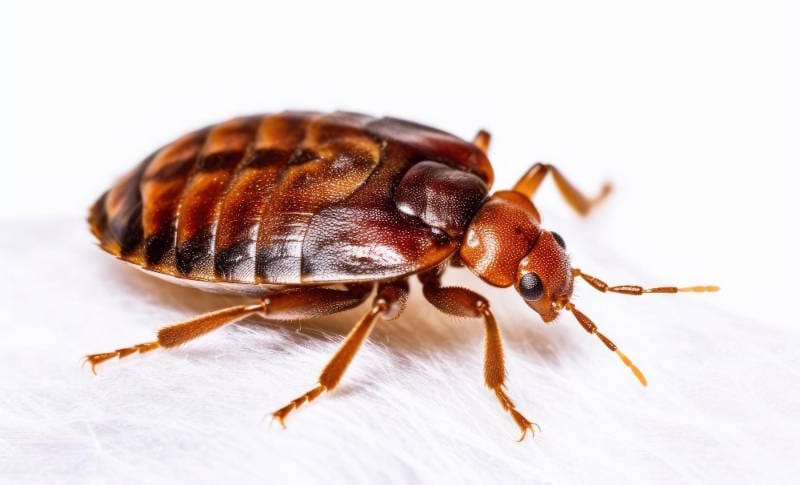Hotel Bed Bug Checks: Tips to Prevent Infestations

Traveling can be an exciting experience, but the last thing you want to encounter during your stay at a hotel is a bed bug infestation. Knowing how to check for bed bugs in a hotel room and safeguard your belongings can help you avoid potential risks. In this guide, we will explore key strategies for identifying, preventing, and managing bed bug infestations in hotels to ensure a comfortable and worry-free stay for travelers.
Key Takeaways
- Inspect hotel rooms thoroughly for signs of bed bugs, including mattress seams, headboards, and furniture crevices.
- Use protective covers for luggage and personal items to prevent bed bug infestations while traveling.
- Report any bed bug infestations promptly to hotel staff to address the issue and prevent further spread.
- Seek medical treatment for bed bug bites and document any expenses for potential reimbursement.
- Understand your rights and hotel policies regarding bed bug infestations to effectively address any concerns or disputes.
Understanding Bed Bug Infestations in Hotels
Bed bug infestations in hotels are a significant concern for travelers. These pests, small and reddish-brown, can hide in mattresses, box springs, and crevices within a hotel room, waiting to hitch a ride on luggage or clothing. Always inspect your hotel room upon arrival, checking the bed, headboard, and upholstered furniture with a flashlight for signs of bed bugs, such as rust-colored spots or exoskeletons. Placing your luggage on a suitcase stand away from walls and beds can also help prevent bringing bed bugs home with you. Awareness and thorough inspection are key to avoiding these unwelcome guests.
Identifying Bed Bug Infestations in Your Hotel Room Expanded
Ensuring a bed bug-free stay in hotels demands vigilance and a keen eye for the subtle signs of these pests. Conducting a detailed inspection of your room upon arrival is critical for identifying potential bed bug infestations.
Detailed Inspection Techniques:
- Mattress and Box Spring: Remove the sheets and inspect the seams and folds of the mattress and box spring for signs of bed bugs, such as small, dark fecal spots or live insects.
- Headboard and Bed Frame: Carefully examine the headboard and bed frame, paying close attention to crevices where bed bugs may hide.
- Upholstered Furniture and Curtains: Check the seams and under cushions of upholstered furniture, and look along the tops and folds of curtains.
- Drawers and Closets: Open all drawers and closets, using a flashlight to inspect the corners and joints for any sign of bed bugs.
Initiating a comprehensive room check not only helps in avoiding the discomfort of bed bug bites but also prevents the spread of these pests to your home.
The Risks of Bed Bug Bites During Travel Expanded
Traveling exposes individuals to the risk of encountering bed bugs, making awareness and precautionary measures essential to safeguard one’s health and peace of mind.
Health and Well-being Considerations:
- Immediate Skin Reactions: Bed bug bites often result in itchy, red welts that can cause discomfort and disrupt sleep.
- Potential for Infection: Scratching the bite sites increases the risk of secondary skin infections, necessitating clean, covered, and treated wounds.
- Psychological Impact: Encountering bed bugs can lead to anxiety and stress, affecting the overall travel experience.
Educating oneself on the risks associated with bed bug bites and the necessary preventive actions can significantly mitigate these concerns. Eliminate bed bugs with our services.
Common Signs of Bed Bug Presence in Hotel Rooms Expanded
Being able to recognize the common signs of bed bug presence is paramount in ensuring a comfortable and pest-free hotel stay.
Key Indicators to Watch For:
- Fecal Spots and Bloodstains: Look for tiny, dark fecal spots or small bloodstains on bedding, which indicate bed bug activity.
- Shed Skins and Eggs: Keep an eye out for shed skins or egg casings in the crevices of mattresses, furniture, and walls.
- Musty Odor: A room with a heavy bed bug infestation may have a noticeable, musty odor from their scent glands.
- Visual Confirmation: Spotting live bed bugs, although challenging due to their elusive nature, is a clear indication of an infestation.
Promptly identifying these signs enables travelers to take swift action, ensuring their health and safety while minimizing the risk of inadvertently transporting bed bugs home.
Safeguarding Your Belongings from Bed Bugs in Hotels
Protecting your belongings from bed bugs while staying in hotels is crucial to prevent inadvertently bringing these pests home. Before settling into your room, use a flashlight to inspect the mattress, box spring, and headboard for any signs of bed bugs, such as small reddish-brown insects or rust-colored spots. Avoid placing your luggage directly on the bed or floor. Instead, use the luggage rack, ensuring it’s away from walls and furniture, or place your suitcase in the bathtub as an extra precaution. Encasing your luggage in plastic bags or protective covers can also offer an additional layer of security against bed bugs.
Best Practices for Placing Your Luggage in Hotel Rooms Expanded
To significantly reduce the risk of encountering bedbugs in hotel rooms, it’s crucial to adopt strategic practices for storing your luggage. Upon entry, refrain from placing your bags on or near the bed, upholstered furniture, or carpeted areas, which are prime habitats for bedbugs.
Enhanced Luggage Storage Methods:
- Elevated Surfaces: Always opt for elevated, hard surfaces like luggage racks or desks, which are less accessible to bedbugs. Before use, inspect these surfaces with a flashlight to check for signs of bedbugs, such as tiny reddish-brown insects or rust-colored spots.
- Bathroom Storage: The bathroom often serves as a safe zone due to its tiled floors and minimal hiding spots. Placing your luggage here can safeguard it from potential infestations.
- Protective Measures: Utilizing sealed plastic bags or specially designed bedbug-proof luggage covers can offer additional protection. These barriers deter bedbugs from accessing your belongings.
- Regular Checks: Periodically inspect your storage area and luggage for any signs of bedbugs, especially if staying for multiple nights.
Or you can reach out to our experts for professional bed bugs removal services.
Inspecting Your Luggage for Bed Bugs Before Departure Enhanced
Before departing from your hotel, a meticulous inspection of your luggage is imperative to prevent inadvertently transporting bedbugs home.
Comprehensive Inspection Tips:
- Detailed Examination: Focus on the seams, pockets, and zippers of your luggage, using a flashlight to spot bedbugs or their eggs. Look for small brown or reddish spots that indicate bedbug presence.
- Clothing and Items: Empty and shake out all contents from your luggage, paying special attention to folds and creases where bedbugs might hide.
- Vacuuming: If available, use a handheld vacuum over your luggage’s surface and interior to capture any lingering bedbugs or eggs.
- Final Check: Before repacking, ensure all your items, especially those that were on or near the bed, have been inspected or cleaned.
Not sure if you might have bed bugs?
Using Protective Covers for Luggage and Personal Items Expanded
Protective covers for luggage and personal items are invaluable in safeguarding against bedbugs during travels. These covers act as a physical barrier, preventing bedbugs from latching onto your belongings.
Selection and Maintenance of Protective Covers:
- Specificity: Choose protective covers explicitly designed for bedbug prevention, ensuring they are made from impermeable materials with secure closures.
- Correct Fit: Ensure the covers snugly fit your luggage and personal items, leaving no openings for bedbugs to enter.
- Protection for Non-Washable Items: Utilize covers for items that cannot be easily laundered, such as electronics, to prevent bedbug infiltration.
- Integrity Checks: Regularly inspect your protective covers for any signs of wear or damage. Immediate replacement is necessary to maintain their protective efficacy.
Incorporating these practices into your travel routine can markedly decrease the risk of bedbug encounters, allowing for a more secure and enjoyable hotel stay.
What to Do If You Find Bed Bugs in Your Hotel Room
Discovering bed bugs in your hotel room requires immediate action. Start by capturing evidence of the infestation, such as taking photos of the bed bugs, their eggs, or fecal spots on linens. Notify hotel management or the front desk right away and request a new room, preferably not adjacent to or directly above or below the infested one. Insist on a room change and ask the hotel to launder your clothes at high heat to kill any bed bugs. Document your communication with the hotel staff for any future claims and consider reporting the incident to local health departments or online review platforms to inform others.
Reporting a Bed Bug Infestation to Hotel Staff
Discovering bed bugs in your hotel room can be unsettling, but it’s crucial to report the issue immediately. Inform the front desk or management as soon as you spot any signs of bed bugs. Be clear and factual about what you’ve found, and request that they take immediate action.
- Take photos or videos as evidence of the infestation.
- Provide specific details about the location and extent of the problem.
- Ask for written confirmation of your report and the hotel’s plan to address the issue.
Remember, a reputable hotel should be responsive to your concerns and willing to offer a solution, such as moving you to another room or providing compensation. It’s important to stay calm and cooperative throughout the process to ensure a swift and effective resolution.
Managing Bed Bug Bites and Seeking Treatment
If you’ve been bitten by bed bugs, immediate care is crucial to prevent infection and alleviate symptoms. Start by gently washing the affected areas with soap and water to reduce the risk of infection. Apply an antiseptic cream or lotion to soothe the skin.
For itching and swelling, consider over-the-counter treatments such as antihistamines or hydrocortisone cream. These can help reduce itching and irritation. If you experience severe reactions or if the bites appear infected, seek medical attention promptly.
Remember to keep all receipts and documentation of treatment if you plan to seek compensation from the hotel. It’s also advisable to inform the hotel staff about the issue so they can take appropriate measures to address the infestation.
Requesting a Room Change or Hotel Refund
If you discover bed bugs in your hotel room, immediately inform the hotel staff and request a room change or a refund. Here’s how to handle the situation effectively:
- Be polite but assertive when explaining the issue to the front desk. Emphasize the importance of a prompt response to prevent further inconvenience.
- Document the infestation with photos or videos as evidence. This can be crucial for any future claims or complaints.
- Ask for a refund of the room’s cost at the very least. You may also request compensation for anyincurred expenses related to the infestation.
- If the hotel is unresponsive or refuses to accommodate your requests, consider escalating the matter by contacting higher management or a consumer protection agency.
Remember, your comfort and safety are paramount. Hotels have a responsibility to provide clean and pest-free accommodations, and you are entitled to fair compensation if this standard is not met. Here are some things for hotel owners to look for in a reliable top Utah bed bugs control company.
Preventing and Managing Post-Travel Bed Bug Concerns
After traveling, managing the risk of introducing bed bugs into your home is essential. Before bringing your luggage inside, inspect it outdoors with a flashlight for any signs of bed bugs. Consider vacuuming your suitcase and washing all your clothes in hot water, regardless of whether you wore them, as heat effectively kills bed bugs. For items that cannot be washed, using a clothes dryer at a high temperature for at least 30 minutes is advisable. Regularly inspecting your sleeping areas and keeping clutter to a minimum can also help identify any bed bug issues early, preventing a full-scale infestation in your home.
Preventing Future Bed Bug Infestations After Travel
After returning from your travels, it’s crucial to take proactive steps to prevent bed bugs from making your home their new residence. Immediately wash all your clothing in hot water and dry them on the highest heat setting to kill any potential hitchhikers. For items that cannot be washed, consider using a garment steamer to apply direct heat.
- Inspect all your luggage thoroughly before bringing it inside your home. Pay special attention to seams, pockets, and crevices where bed bugs may hide.
- Vacuum your suitcases and bags outside before storage.Empty the vacuum bag or canister outside to prevent any bed bugs from escaping into your home.
By following these measures, you can significantly reduce the risk of a bed bug infestation in your home. Remember, vigilance is key when it comes to these persistent pests.
Cleaning and Treating Belongings After Exposure to Bed Bugs
After a potential exposure to bed bugs, it’s crucial to clean and treat your belongings to prevent bringing these pests into your home. Start by sorting your items based on the care instructions and fabric types.
- For items that can withstand high temperatures,wash in the hottest water and dry using the highest dryer setting the items can tolerate. This heat treatment is often effective in killing bed bugs.
- For delicate items that may be damaged by heat, consider sealing them in a plastic bag and placing them in the freezer for at least four days. Freezing temperatures can also exterminate bed bugs.
Remember to vacuum out your luggage and any other carry-ons before storing them away. Dispose of the vacuum bag or clean the vacuum container immediately to ensure no bed bugs remain.
Knowing Your Rights and Hotel Policies on Bed Bugs
It’s crucial to be aware of your rights when encountering bed bugs in a hotel. Many states have regulations that require hotels to maintain certain standards of cleanliness and pest control. Here’s what you should know:
- Review the hotel’s policy on bed bugs before your stay. This information can often be found on their website or by contacting the hotel directly.
- If you encounter bed bugs, report the issue immediately to hotel management. They are typically required to take action to resolve the problem.
- Understand that21 states have some level of regulation regarding bed bugs, focusing on hotels and property managers. This means there may be legal recourse if the hotel fails to address the issue adequately.
Always keep records of any communications with the hotel regarding bed bugs, as this can be important if you need to seek compensation or take legal action.
Conclusion
In conclusion, being vigilant and proactive in checking for bed bugs in hotel rooms is essential to safeguarding yourself from potential infestations and bites. By following the best practices outlined in this guide, you can protect your belongings and ensure a comfortable and bed bug-free stay during your travels. Remember, early detection and reporting are key in preventing the spread of bed bugs in hotels. Stay informed, stay cautious, and enjoy your travels with peace of mind.

